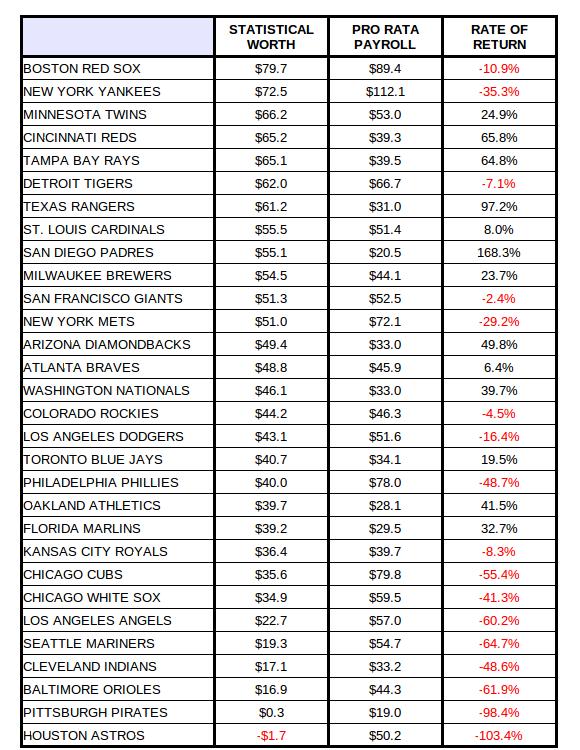Polaroid
I need a tittle
- Since
- Jan 21, 2010
- Messages
- 2,890
- Score
- 3
- Tokens
- 0
When the New York Yankees have a $200 million payroll, they are accused of buying the World Series even though the Florida Marlins have won it all twice on a fraction of that money. When the Chicago Cubs or the New York Mets have a $140 million payroll and can't even make the playoffs, people just laugh at them. So how important is the level of payroll in baseball? More specifically, how important has the level of payroll been so far this season?
Using sabermetric analysis of each player for each team, calculating a win share for each player and then applying a dollar figure to each win gives the monetary contribution of each player and thus for the team as a whole. This is not an exact science since injuries of highly paid players are going to have a negative effect on the production to payroll ratio; also any players under club control being paid less than their market worth will skew the figures (although having young productive players on cheap contracts is one aspect of a well run MLB team) but this should even out when all teams are analyzed. The payroll data is taken from CBS Sports as the opening day salary and so does not take into account any personnel changes during the season although any rosters move would not adversely skew the true payroll figures.

Not surprisingly, there is a positive correlation between the level of payroll and the statistical output of a team; if there wasn't then the Yankees would be putting away their checkbook and every team would shoot for a Pirates size payroll.
Conversely the rate of return, taken as the difference between payroll and statistical worth as a percentage of payroll, gives a different story. With the Padres, Rangers, Rays and Reds in the top third of the table despite each having a sub $40 million prorata payroll and the Cubs, White Sox, Angels, Mariners and Astros in the bottom third despite all having a $50+ million payroll it would seem that high spending does not equate to high return. In fact there is a strong negative correlation (-0.422) between payroll and return to payroll so the higher a team spends, the less proportional return they should expect from their outlay.
.
Using sabermetric analysis of each player for each team, calculating a win share for each player and then applying a dollar figure to each win gives the monetary contribution of each player and thus for the team as a whole. This is not an exact science since injuries of highly paid players are going to have a negative effect on the production to payroll ratio; also any players under club control being paid less than their market worth will skew the figures (although having young productive players on cheap contracts is one aspect of a well run MLB team) but this should even out when all teams are analyzed. The payroll data is taken from CBS Sports as the opening day salary and so does not take into account any personnel changes during the season although any rosters move would not adversely skew the true payroll figures.

Not surprisingly, there is a positive correlation between the level of payroll and the statistical output of a team; if there wasn't then the Yankees would be putting away their checkbook and every team would shoot for a Pirates size payroll.
Conversely the rate of return, taken as the difference between payroll and statistical worth as a percentage of payroll, gives a different story. With the Padres, Rangers, Rays and Reds in the top third of the table despite each having a sub $40 million prorata payroll and the Cubs, White Sox, Angels, Mariners and Astros in the bottom third despite all having a $50+ million payroll it would seem that high spending does not equate to high return. In fact there is a strong negative correlation (-0.422) between payroll and return to payroll so the higher a team spends, the less proportional return they should expect from their outlay.
.
Last edited: